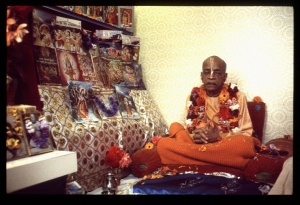CC Adi 13.74: Difference between revisions
m (1 revision(s)) |
(Vanibot #0054 edit - transform synonyms into clickable links, which search similar occurrences) |
||
| (One intermediate revision by one other user not shown) | |||
| Line 1: | Line 1: | ||
{{ | [[Category:Sri Caitanya-caritamrta - Adi-lila Chapter 13|C074]] | ||
<div style="float:left">'''[[Sri Caitanya-caritamrta|Śrī Caitanya-caritāmṛta]] - [[CC Adi|Ādi-līlā]] - [[CC Adi 13|Chapter 13: The Advent of Lord Śrī Caitanya Mahāprabhu]]'''</div> | |||
<div style="float:right">[[File:Go-previous.png|link=CC Adi 13.73|Ādi-līlā 13.73]] '''[[CC Adi 13.73|Ādi-līlā 13.73]] - [[CC Adi 13.75|Ādi-līlā 13.75]]''' [[File:Go-next.png|link=CC Adi 13.75|Ādi-līlā 13.75]]</div> | |||
{{CompareVersions|CC|Adi 13.74|CC 1975|CC 1996}} | |||
{{RandomImage}} | |||
==== TEXT 74 ==== | ==== TEXT 74 ==== | ||
<div | <div class="verse"> | ||
tabe putra janamilā ‘viśvarūpa’ nāma | :tabe putra janamilā ‘viśvarūpa’ nāma | ||
mahā-guṇavān teṅha—‘baladeva’-dhāma | :mahā-guṇavān teṅha—‘baladeva’-dhāma | ||
</div> | </div> | ||
| Line 12: | Line 16: | ||
==== SYNONYMS ==== | ==== SYNONYMS ==== | ||
<div | <div class="synonyms"> | ||
''[//vanipedia.org/wiki/Special:VaniSearch?s=tabe&tab=syno_o&ds=1 tabe]'' — ''thereafter; ''[//vanipedia.org/wiki/Special:VaniSearch?s=putra&tab=syno_o&ds=1 putra]'' — son; ''[//vanipedia.org/wiki/Special:VaniSearch?s=janamilā&tab=syno_o&ds=1 janamilā]'' — took birth; ''[//vanipedia.org/wiki/Special:VaniSearch?s=viśvarūpa&tab=syno_o&ds=1 viśvarūpa]'' — Viśvarūpa; ''[//vanipedia.org/wiki/Special:VaniSearch?s=nāma&tab=syno_o&ds=1 nāma]'' — named; ''[//vanipedia.org/wiki/Special:VaniSearch?s=mahā&tab=syno_o&ds=1 mahā]-[//vanipedia.org/wiki/Special:VaniSearch?s=guṇavān&tab=syno_o&ds=1 guṇavān]'' — highly qualified; ''[//vanipedia.org/wiki/Special:VaniSearch?s=teṅha&tab=syno_o&ds=1 teṅha]'' — He; ''[//vanipedia.org/wiki/Special:VaniSearch?s=baladeva&tab=syno_o&ds=1 baladeva]'' — of Lord Baladeva; ''[//vanipedia.org/wiki/Special:VaniSearch?s=dhāma&tab=syno_o&ds=1 dhāma]'' — incarnation. | |||
</div> | </div> | ||
| Line 19: | Line 23: | ||
==== TRANSLATION ==== | ==== TRANSLATION ==== | ||
<div | <div class="translation"> | ||
After this, Jagannātha Miśra got a son of the name Viśvarūpa, who was most powerful and highly qualified because He was an incarnation of Baladeva. | After this, Jagannātha Miśra got a son of the name Viśvarūpa, who was most powerful and highly qualified because He was an incarnation of Baladeva. | ||
</div> | </div> | ||
| Line 26: | Line 30: | ||
==== PURPORT ==== | ==== PURPORT ==== | ||
<div | <div class="purport"> | ||
Viśvarūpa was the elder brother of Gaurahari, Lord Śrī Caitanya Mahāprabhu. When arrangements were being made for the marriage of Viśvarūpa, He took sannyāsa and left home. He took the sannyāsa name of Śaṅkarāraṇya. In 1431 Śakābda Era (A.D. 1509), He disappeared in Pāṇḍarapura, in the district of Sholapur. As an incarnation of Saṅkarṣaṇa, He is both the ingredient and immediate cause of the creation of this material world. He is nondifferent from Śrī Caitanya Mahāprabhu, for the aṁśa and the aṁśī, or the part and the whole, are not different. As an incarnation of Saṅkarṣaṇa, Viśvarūpa belongs to the quadruple manifestation of catur-vyūha. In the Gaura-candrodaya it is said that Viśvarūpa, after His so-called demise, remained mixed within Śrī Nityānanda Prabhu. | Viśvarūpa was the elder brother of Gaurahari, Lord Śrī Caitanya Mahāprabhu. When arrangements were being made for the marriage of Viśvarūpa, He took ''sannyāsa'' and left home. He took the ''sannyāsa'' name of Śaṅkarāraṇya. In 1431 Śakābda Era (A.D. 1509), He disappeared in Pāṇḍarapura, in the district of Sholapur. As an incarnation of Saṅkarṣaṇa, He is both the ingredient and immediate cause of the creation of this material world. He is nondifferent from Śrī Caitanya Mahāprabhu, for the ''aṁśa'' and the ''aṁśī'', or the part and the whole, are not different. As an incarnation of Saṅkarṣaṇa, Viśvarūpa belongs to the quadruple manifestation of ''catur-vyūha''. In the ''Gaura-candrodaya'' it is said that Viśvarūpa, after His so-called demise, remained mixed within Śrī Nityānanda Prabhu. | ||
</div> | </div> | ||
__NOTOC__ | |||
<div style="float:right; clear:both;">[[File:Go-previous.png|link=CC Adi 13.73|Ādi-līlā 13.73]] '''[[CC Adi 13.73|Ādi-līlā 13.73]] - [[CC Adi 13.75|Ādi-līlā 13.75]]''' [[File:Go-next.png|link=CC Adi 13.75|Ādi-līlā 13.75]]</div> | |||
__NOTOC__ | |||
__NOEDITSECTION__ | |||
Latest revision as of 18:26, 19 February 2024

A.C. Bhaktivedanta Swami Prabhupada
TEXT 74
- tabe putra janamilā ‘viśvarūpa’ nāma
- mahā-guṇavān teṅha—‘baladeva’-dhāma
SYNONYMS
tabe — thereafter; putra — son; janamilā — took birth; viśvarūpa — Viśvarūpa; nāma — named; mahā-guṇavān — highly qualified; teṅha — He; baladeva — of Lord Baladeva; dhāma — incarnation.
TRANSLATION
After this, Jagannātha Miśra got a son of the name Viśvarūpa, who was most powerful and highly qualified because He was an incarnation of Baladeva.
PURPORT
Viśvarūpa was the elder brother of Gaurahari, Lord Śrī Caitanya Mahāprabhu. When arrangements were being made for the marriage of Viśvarūpa, He took sannyāsa and left home. He took the sannyāsa name of Śaṅkarāraṇya. In 1431 Śakābda Era (A.D. 1509), He disappeared in Pāṇḍarapura, in the district of Sholapur. As an incarnation of Saṅkarṣaṇa, He is both the ingredient and immediate cause of the creation of this material world. He is nondifferent from Śrī Caitanya Mahāprabhu, for the aṁśa and the aṁśī, or the part and the whole, are not different. As an incarnation of Saṅkarṣaṇa, Viśvarūpa belongs to the quadruple manifestation of catur-vyūha. In the Gaura-candrodaya it is said that Viśvarūpa, after His so-called demise, remained mixed within Śrī Nityānanda Prabhu.